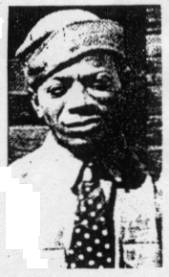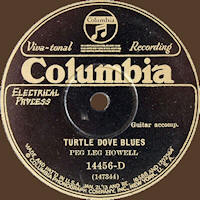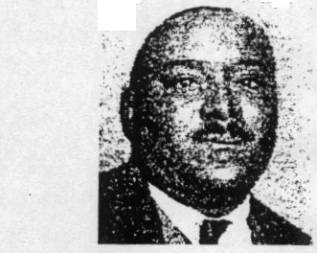
Painting © 2004 Loz
Arkle
Website
© Copyright 2000-2011 Alan White - All
Rights Reserved
Site optimised for Microsoft Internet Explorer



"The Birds
and the Blues"
|
|
Blues singers have always drawn on their environment for inspiration in their lyrics as well as in the sound of their instruments. Unlike the traditional folk singer who will often sing of events that happened many years previous to their own experience -sometimes referring to events spanned by centuries. Such is the case with the execution ballads of Captain Kidd from the l7th. Century for example. It is true there are a handful of “blues ballads” such as “John Henry”, “Stack 0’ Lee” or Frankie & Albert/Johnnie”, which have persisted in black song but they are the exception to the rule - the vast majority of blues reflected their surroundings in the “here and now”. So a pianist or guitarist would imitate the rhythms of the train wheels in the late l9th. Century, which finally resulted in boogie-woogie. They would also mimic the fireman ringing his bell, while the harp blower reproduced the lonesome sound of the train whistle as it sped through the Southern countryside. The bobbing movements of logs floating downstream to the sawmill, are brilliantly captured by Charlie Patton’s guitar on his “Green River Blues”; reflecting his days in the logging camps in Mississippi. But one of the first sounds to inspire a blues singer was a natural one - the sounds of a bird singing. A story handed down by ex-slaves claims that one evening a slave was feeling low in spirit and heard a plaintive cry of a night bird. The sound inspired the slave to get a piece of cane from a canebrake and cut some holes in it. He then commenced to play a “blues” on his whistle. As time went by, the instrument evolved into a set of “quills”. One definition of a quill runs: “a piece of reed used by weavers”(1). Paul Oliver quotes a report by U.S. writer, George Cable, in 1886 which refers to a “black lad” cutting 3 reeds from “the edge of the canebrake.. .blowing and hooting, over and over,"(2). Cable stated that blacks called these 3 reeds “quills”. On l2th April 1927, Big Boy Cleveland recorded 2 quill solos, for Gennett, one of which was issued. “Quill Blues” which lets the instrument “sing” the blues, could not have been too far removed from the l7tn.Century ex-African slave in the canebrake. An almost unique example on record, significantly, Cleveland’s only other issued side featured vocal and guitar, in the style of Furry Lewis. For this reason alone, I suspect, the only “fact” stated about Cleveland is that he could have been from Memphis Tennessee. which was Furry’s home base and an important centre for the Blues in the 1920s. The only other example of quills or “pan-pipes” as they became known (from ”Pan’s pipes”) on a commercial blues record was by the Texas songster, Henry Thomas. Also known as “Rag Time Texas”, he started recording some 3 months after Cleveland’s session and played a set of pan-pipes on a rack around his neck while also playing guitar. He featured this combination for nearly half of his issued output of 23 sides. The technical term for quills or pan-pipes is a syrinx. One definition of which is “the organ of voice in birds.”(3). U.S. blues writer, Sam Charters, description runs: “Each “pipe” is a cross blown cane reed, held against the lips while the player blows across the opening in the top, just as a child blows on an empty bottle. The pitch of the reed is determined by its length - the shorter the reed the higher the sound - and usually the player binds a group of them together in a row, holding them together with pieces of stick.”(4). Engineers in early locomotives in the l9th.Century had a set of pipes for a train whistle, also called ‘quills’. The most famous being Casey Jones on the Illinois Central. Freeman Hubbard relates that “By “valving”, or changing the pressure of steam admitted into the quill, engineers could change the tones and even play tunes”.(5). These train whistles were mounted “ahead of the smokestacks and using parabolic amplifiers.”(6), around 1890,when Casey Jones was stamping his own individuality on the Delta landscape. Jones “had a home-made six-chime whistle with six slender tubes bound together, the shortest being exactly half the length of the largest. With its interpretive tone, the “ballast scorcher” could make the quill say its prayers or scream like a banshee.” (7). obviously inspired by black singers using the quills or syrinx, like Henry Thomas and Big Boy Cleveland, Casey’s “plaintive moans” could be heard right up to that fateful day in 1900. It was at Vaughan, Mississippi. that around the curve came another I. C. passenger train and “Number Four stabbed ‘im in the face"(8), as Furry Lewis recalled some 28 years later, for Victor records.
Casey’s
home-made whistle, Intriguingly, from the same state came the Birmingham Jug Band who recorded 9 sides at a single session in 1930; including ‘Cane Brake Blues”. This consisted of a series of 1-line verses and points to an embryonic form of the more usual 3 line format found in the Blues. The harp player, unidentified, has been suggested as Jaybird Coleman, based in Birmingham, Alabama. Together with the obscure Ollis Martin, these musicians form the nearest to a “blues tradition” in Alabama, as Oliver suggests.
Jaybird Coleman c. 1917 Another bird common in Southern states, is the brightly coloured bluebird, and its song is recalled by Winston Holmes when he cut a vocal duet with the “Kansas City Butter Ball”, otherwise Lottie Beaman. Holmes, a music promoter and tap dancer from Kansas City Mobile apart from yodelling and his ‘bird effects’, also put in his own vocal support when Lottie sang in mock seriousness: “I
wish I had wings like an aeroplane, that flies in the heavens above.
“If I had
wings like Noah’s turtle dove.(x3) “I weep like a willow, moan like a dove.” (12).
Peg Leg Howell c. 1926
“Many of Howell’s blues verses dated back to the earliest stanzas noted by collectors: verses....in “Turtle Dove Blues” were noted by John A. Lomax in 1908 when tie collected them from the Mississippi levee woman Dink as she was washing for the levee workers on the Brazos River in Texas.”(14). A younger Georgia singer playing a 12-string guitar, Barbecue Bob, used the ‘turtle dove’ phrase as an endearment for his prospective lover: “Can’t you near me
beggin’, From Georgia to Missouri and the fine, St. Louis-based singer, Luella Miller who used the traditional “If I had wings” verse on her’ low-down moan “Walnut Street Blues” where the “Blues passed her door”, backed by possibly Elmore Booker on some inventive piano. As Oliver said in his sleeve notes “On this (“Walnut St. Blues”) the piano was particularly adept, imitating a bird’s flight...”(16), as well as a freight train stopping, in the ‘following verse. In a more lightweight vaudeville—blues style, Marie Grinter sang more unusual “mourning dove” verses: “Early in the mornin’, Grinter ended her blues with these lines: “Mournin’ Dove Blues
is a woman is hard to please. (x2) Some 11 years later, U.S. Decca got a prisoner out on parole so they could record him. A tough two-fisted pianist, possibly from Texas, the singer called himself “Jesse James” and for the traditional bawdy tune “Sweet Patunia”, he used lyrics to capture some of the “shocking” atmosphere of this song, without upsetting the record company censor. To this end, he incorporated some of Peg Leg Howell’s lines with a mildly disgusting image of his own!, “Now wake up mama, wake up
an’ don’t sleep so sound; It didn’t work; Decca didn’t issue the title, and returned “James” back to jail! But the Peg Leg Howell version, with its Old Testament overtones, persisted into the 195Os,at least. Famous R’nB singer/pianist, Fats Domino, elaborated on the religious vein in “The Prisoner’s Song” for Imperial records. As I recall, Fats sang: “If I had the wings of an
angel, over these prison wails I’d fly; The New Orleans piano man was
perpetuating part of an oral tradition that went back to the medicine/minstrel
shows of the l9th. Century. Another song, recorded a few months earlier than Howell’s “Turtle Dove Blues” was “Green Grass” and with its “Green Grow The Rushes 0” structure, would have fitted just right on a medicine show of the 1880s. Accompanied by ”Georgia Tom” Dorsey on jaunty piano, Stovepipe Johnson appears to be parodying white minstrelsy and country music as well. Commencing with “the hole in the ground an’ green grass grows all round”, Johnson punctuates each new line with a pseudo falsetto-cum-yodel; here underlined: “now in that egg there
was a little bird, This was, as I’ve implied, more in the medicine show/hokum blues genre. But birds and birds’ nests occurred in the heavy Delta blues as well; as Charlie Patton relates to the pulsating, guitar-slapping rhythm that he and Willie Brown were putting down in 1930: “Come on mama, come to the
edge of town; “If I was a bird, mama, Patton was to re-record this no. as “Revenue Man Blues” in 1934,without Brown, and still seemed to generate the same kind of intense, driving beat!, “Bird Nest Bound” might have been inspired by a 1926 record by Ardell “Shelly” Bragg (a female singer), ”Bird Nest Blues”, or more likely part 4 of Jim Jackson’s big hit “Jim Jackson’s Kansas City Blues”, which included the lines: “I wish I’se a jaybird
flyin’ in the air, Copyright © 2000 Max Haymes. All Rights Reserved. References1. R. F. Patterson (Ed.). “The Cambridge English Dictionary”. Tophi Books. 1990. P332. 2. Paul Oliver. Quoted in “Story Of The Blues”. Barrie & Rockliff, The Cresset Press 3. Patterson. Ibid. p.412. 4. Samuel Charters. “The Bluesmen”. Oak Pub. 1967. p.191. 5. Freeman Hubbard. “Encyclopedia of North American Railroading”. McGraw-Hill Book Co. 1981. p.354. 6. Ibid. 7. Ibid. 8. “Kassie Jones—Part 1”. Furry Lewis vo. gtr. 28/8/28. Memphis, Tenn. 9. Paul Oliver. Notes to “Alabama Harmonica Kings 1927—30” L.P. Wolf WSE 127. c.1985. 1O.”LostLover Blues”. Lottie Beaman vo., speech; Winston -Holmes vo., bird effects, yodelling; prob. Miles Pruitt gtr. 21/8/28. Richmond, Ind. 11.”Turtle Dove Blues”. Peg Leg Howell vo. gtr. 30/10/28. Atlanta, Ga. 12 Ibid. 13.Paul Oliver. “Songsters & Saints”. Cambridge U. Press. 1984. p.257. 14.Ibid. p.19. 15.”Beggin’ For Love”. Barbecue Bob vo. gtr., speech. 27/10/28 Atlanta, Ga. 16.Paul Oliver. Notes to “Lottie Beaman 1924/26 and Luella Miller 1928”. L.P. Wolf WSE 124. c.1986. 17 . “Morning Dove Blues” (sic). Marie Grinter vo.;unk. cit.; alt.;vln.;pno. 6/4/25. Richmond, In d. 18.Ibid. 19.“Sweet Patuni”. Jesse James vo. pno. 3/6/36. Chicago, Ill. 20.“Prisoner’ s (Love) Song”. Fats Domino vo. pno.;acc. by His Band: including Herb Hardesty or Lee Allenten.;Roy Montrell gtr. c.1958. 21.”Green Grass”. Stovepipe Johnson vo. ;Georgia Tom pno. 26/ 7/28. Chicago,Ill. 22.”Bird Nest Bound”. Charlie Patton vo.gtr., speech; Willie Brown gtr. c.28/5/30. Grafton Wis. 23.”Jim Jackson’s Kansas City Blues—Part 4”. Jim Jackson vo gtr. 22/1/28. Chicago, Ill.__________________________________________________________________________
Website © Copyright 2000-2011 Alan White. All Rights Reserved. |







 Lottie Beaman’s verse seems
to be an update of an older one which Georgia guitarist, Peg Leg Howell used on
his “Turtle Dove Blues”. Sang Howell:
Lottie Beaman’s verse seems
to be an update of an older one which Georgia guitarist, Peg Leg Howell used on
his “Turtle Dove Blues”. Sang Howell:
